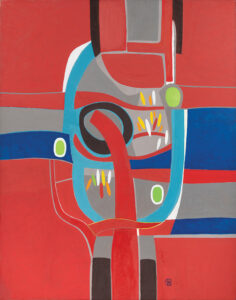
Charting the path of a modern master
by William Corwin
Gilot’s line is the first thing you notice, her tool for expressing an image. In her portraits in pencil, the line becomes the central element, almost tattooed into the paper. In her paintings, both figurative and abstract, Gilot’s line acts either as a boundary of form or as a central element or elements, weaving in and out amongst the other forms or creating complicated knots and patterns. Rosenberg & Co., in New York City, is presenting a survey of Gilot’s work this spring, the first since the artist’s death at age 101 a year ago. The works on view, through July 3, cover seven decades of her practice, starting with drawings and paintings from 1944, meandering through myriad works on paper, monotypes, oils, and ending with an abstract painting from 2007.
Sunflowers, 1958, oil on canvas, 37 x 29 in.
© Françoise Gilot courtesy of Rosenberg & Co., New York
Françoise Gilot was born in 1921 in Neuilly on the outskirts of Paris. She was an only child who came from a wealthy background, one which allowed her many opportunities and much choice early on in life. Her father frequently made it clear that he had desired a son, but that being said, he then showered her (or burdened her) with all the advantages he would have given a boy, including taking her hunting. In one bizarre anecdote Gilot narrated in Malte Herwig’s The Woman Who Says No, her father had her locked in a chimpanzee cage at the Antwerp Zoo in 1926—Gilot was five—as a kind of prank-cum-toughening-up exercise.
While her parents were supportive of her interest in art, it was an education in law that her father wanted for his daughter. She took drawing classes at the Académie Ranson, while studying law at the Sorbonne, and had private art classes with the dashing Hungarian-Jewish artist Endre Rozsda (1913–1999), who (at that time) was a Surrealist. Through Rozsda, Gilot became familiar with the Paris art scene and began exhibiting her work in 1943 with fellow artist Geneviève Aliquot at Madeleine Decre’s gallery in the Rue Boissy-d’Anglas. In February of that year, Rozsda had to leave Paris, and Gilot’s father was able to get him papers returning him safely to Budapest. A few months later, in May, Gilot was introduced to Picasso.

The Tree of Life, 2002, oil on canvas, 63.8 x 52 in.
© Françoise Gilot courtesy of Rosenberg & Co., New York
Gilot’s book Life with Picasso, published in 1964, is a gem of the memoir genre. Through its meticulous recounting of conversations and encounters, the reader becomes profoundly acquainted with Gilot. As a young woman in Paris, meeting artists—mostly men—she quickly sized up the socio-sexual dynamics of the French art scene and decided that utilizing Picasso, the most famous painter in the world at that time, as a teacher, would benefit her artistic practice. In Life with Picasso, we are treated to many of the same lessons in composition and painting which Gilot experienced, word-for-word. It’s important to realize that Gilot kept Picasso at arm’s length for many months at first, engaging him intellectually, despite his almost endless sexual harassment. For better or for worse, and Gilot is both very sanguine and romantic about her relationship with the painter, she eventually fell in love with Picasso and lived with him from 1946 to 1953. They had two children, Claude and Paloma.
Incertitude, 2003-4, oil on canvas, 9.8 x 9.8 in.
© Françoise Gilot courtesy of Rosenberg & Co., New York
In the exhibition at Rosenberg & Co., one of the earliest works is an oil painting, Red Harbor Douarnenez (Le port Rhu, Douarnenez), from 1944, in which Gilot has presented a wide harbor vista in a succinct and flat series of interlocking planes of muted color. Perhaps it was her recent interactions with Surrealism, through her teacher Rozsda, now transmogrified via Cubism, that led to a unique and tightly controlled manipulation of color and space. While the distant town on a far shore, the intervening water in the middle-ground, and the boats resting on the sand in the foreground are all carefully rendered, the painter has artificially reconfigured the spatial dynamics in order to create a puzzle-like interlocking of form, highlights, and shadows. This careful artificiality also manifests in a drawing of Picasso from the same year and becomes the hallmark of her pencil and line-based portraits. Space on the paper is insistently flat; the painter’s face is defined purely by unshaded delineations, sometimes darkened, or emphasized by repeated strokes, creating a fuzzy line. Without volumetric shading, the eye immediately focuses on the darker lines, in this case the pupils, jawline, and bald pate of her 63-year-old lover. This flattening of volumes combined with a line that serves as a primary means of depicting space are two methods that Gilot will employ for the rest of her career.

